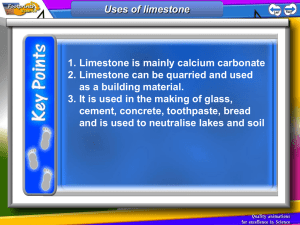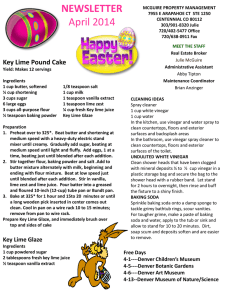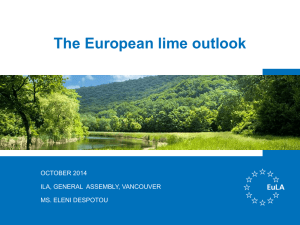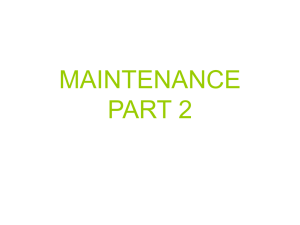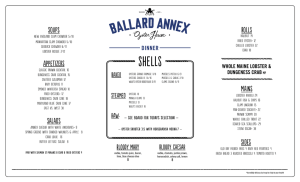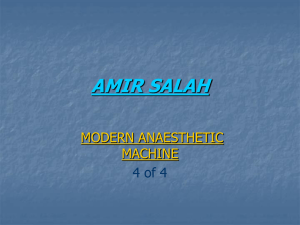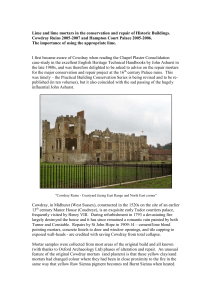CE 244
advertisement
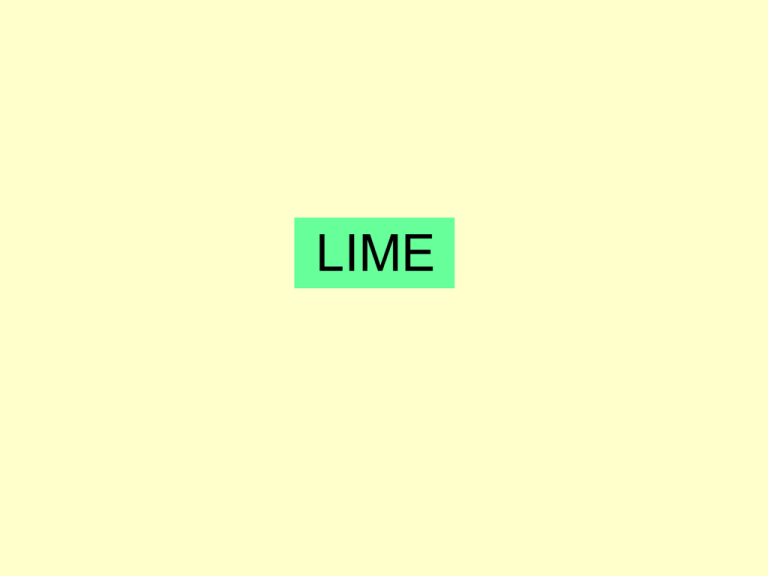
LIME Lime • Naturally occurs as: Limestone Lime • Chemistry for pure rock: CaCO3 (calcium carbonate) but, impurities are always present: MgCO3,Al2O3, Fe2O3, SiO2 marine animals Production • • • • • • • • • Excavation Crushing Limestone Grinding Calcination → Quicklime Pulverize quicklime Mix with water under pressure → Slaked Lime Drying of Slaked Lime Pulverizing Marketing in bags. Calcination CaCO3 CaO + CO2 ( > 900°C) “quick lime” • Calcination is carried out in kilns: - Intermittent - Continuous - Rotary - Reactor Intermittent Kiln 1 crushed limestone 1. Load kiln 2. Calcine 4 3. Cool 4. Unload kiln 1. Load kiln quick lime . . heat 2 3 . Continuous Kiln crushed limestone heat heat air ash + quick lime Rotary Kiln Finely crushed limestone Reactor Kiln ground limestone Hot pressurized air Cooling compartment Classification of Quicklime 1. According to Particle Size • • • • • • Lump Lime (10-30 cm lumps) Pebble Lime (2-5 cm) Granular Lime (~0.5 cm) Crushed Lime (~5-8 mm) Ground Lime (passes #10 sieve, by grinding crushed lime) Pulverized Lime (passes #100 sieve) Classification of Quicklime 2. According to Chemical Composition • • • • High-Calcium Quicklimes (~90% CaO) Calcium Quicklime (75% CaO) Magnesian Quicklime ( > 20% of MgO) Dolomitic Quicklime ( > 25% of MgO) 3. According to Intended Use • • Mortar Lime Plaster Lime Slaking of Lime (Hydration) CaO + H2O → Ca(OH)2 + Heat (i.e. exothermic) CaO is mixed with water in a slaking box until a “putty” has been formed. The putty is then covered with sand to protect it from the action of the air & left for seasoning. Time of seasoning →1 week for mortar use 6 weeks for plaster use If CaO is not slaked well, it will absorb moisture from air & since the volume expands up to 2.5-3 times popouts will occur. Slaked lime can also be bought from a factory. It is more homogeneous & economical but less plastic. Seasoning provides a homogeneous mass & completion of chemical reactions During slaking heat evolves & volume expands. Factors affecting heat evolution and rate of slaking • Quicklime particle size • Chemical composition • Burning temperature Hardening of Slaked Lime air Ca (OH)2 + CO2 → CaCO3 + H2O Air-Slaked Lime At surface of uncovered quicklime (CaO) it picks up moisture and CO2 from air becomes partly CaCO3. Expansion observed CaO + H2O → Ca(OH)2 Ca(OH)2 + CO2 → CaCO3 + H2O Lime Pops If quicklime is not mixed completely with water some CaO will be carried to construction stage. In its final stage it will absorb water & CO2 from air and will expand upto 2.5-3 times. This will cause cracking & pop-outs in the structure. Properties of Lime Mortars Lime + sand lime mortar Adding sand: - Adjusts plasticity – otherwise too sticky - Provides economy - Decreases shrinkage effects Strength of Lime Mortars Chemical composition of lime Magnesian Limes > Calcium Limes Sand amount & properties Adding sand decreases strength Amount of water Voids are formed after evaporation Setting conditions Lower humidity & higher CO2 higher strength Properties of High-Calcium Limes Slakes faster Hardens faster Have greater sand carrying capacity Durability of Limes Not resistant to moving water Not for use outside hydraulic binder ??? Uses of Lime In producing masonry mortars Plaster mortars – sets slower than gypsum White-wash In production of masonry blocks – slaked lime + sand under pressure Hydraulic Lime Obtained by calcination of siliceous or clayey limestone at higher temperature It differs from quicklime: - Burned at higher temperature - It contains lime silicates - It can set & harden under water
